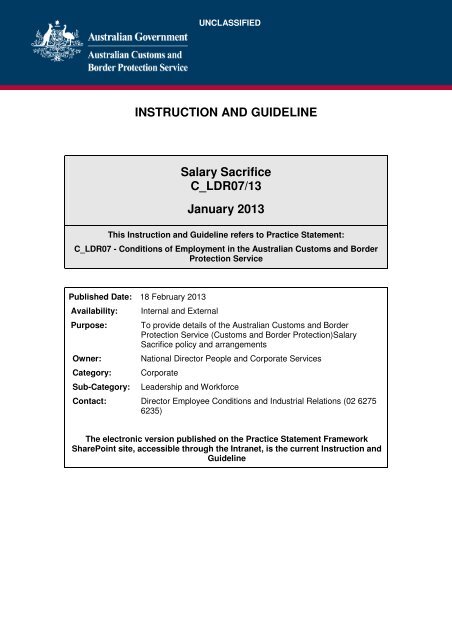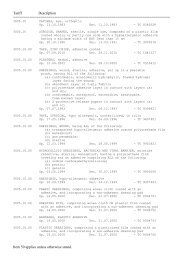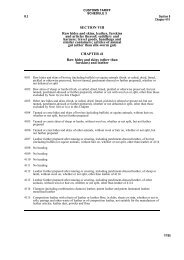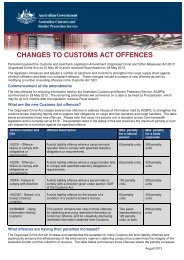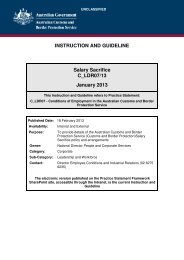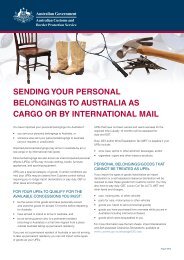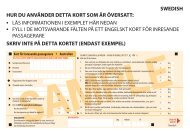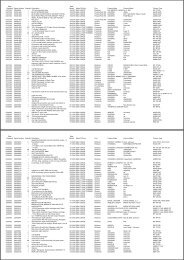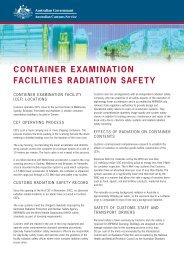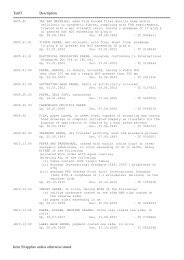Salary Sacrifice - Australian Customs Service
Salary Sacrifice - Australian Customs Service
Salary Sacrifice - Australian Customs Service
Create successful ePaper yourself
Turn your PDF publications into a flip-book with our unique Google optimized e-Paper software.
UNCLASSIFIED<br />
INSTRUCTION AND GUIDELINE<br />
<strong>Salary</strong> <strong>Sacrifice</strong><br />
C_LDR07/13<br />
January 2013<br />
This Instruction and Guideline refers to Practice Statement:<br />
C_LDR07 - Conditions of Employment in the <strong>Australian</strong> <strong>Customs</strong> and Border<br />
Protection <strong>Service</strong><br />
Published Date: 18 February 2013<br />
Availability: Internal and External<br />
Purpose: To provide details of the <strong>Australian</strong> <strong>Customs</strong> and Border<br />
Protection <strong>Service</strong> (<strong>Customs</strong> and Border Protection)<strong>Salary</strong><br />
<strong>Sacrifice</strong> policy and arrangements<br />
Owner: National Director People and Corporate <strong>Service</strong>s<br />
Category: Corporate<br />
Sub-Category: Leadership and Workforce<br />
Contact: Director Employee Conditions and Industrial Relations (02 6275<br />
6235)<br />
The electronic version published on the Practice Statement Framework<br />
SharePoint site, accessible through the Intranet, is the current Instruction and<br />
Guideline
Table of Contents<br />
UNCLASSIFIED<br />
Table of Contents ................................................................................................................ 2<br />
Introduction ......................................................................................................................... 3<br />
1. Definition ................................................................................................................... 4<br />
2. <strong>Salary</strong> sacrifice as offered by <strong>Customs</strong> and Border Protection ............................ 4<br />
3. <strong>Salary</strong> sacrifice items ............................................................................................... 4<br />
4. What is salary for salary sacrificing purposes? ..................................................... 4<br />
5. How much salary can be sacrificed? ...................................................................... 5<br />
6. Insufficient Funds..................................................................................................... 5<br />
7. <strong>Salary</strong> sacrifice providers ........................................................................................ 5<br />
7.1 Motor Vehicle packaging and Airline Lounge membership ...................................... 5<br />
7.2 Superannuation ...................................................................................................... 5<br />
8. Superannuation policy and process ....................................................................... 6<br />
9. <strong>Salary</strong> <strong>Sacrifice</strong> and Fringe Benefits Tax (FBT) ..................................................... 6<br />
10. ‘Exempt car benefits’ ............................................................................................... 7<br />
11. Separations ............................................................................................................... 7<br />
12. Financial advice ........................................................................................................ 7<br />
13. Additional Information ............................................................................................. 7<br />
14. Related Policies and References ............................................................................. 8<br />
15. Key Roles and Responsibilities ............................................................................... 8<br />
16. Consultation ............................................................................................................. 8<br />
16.1 Internal Consultation ............................................................................................... 8<br />
16.2 External Consultation .............................................................................................. 8<br />
Endorsement ....................................................................................................................... 9<br />
Approval .............................................................................................................................. 9<br />
2
Summary of main points<br />
UNCLASSIFIED<br />
The key principle of salary sacrifice arrangements is that it entails no additional<br />
cost to <strong>Customs</strong> and Border Protection<br />
Employees are encouraged to seek financial advice prior to commencing salary<br />
sacrifice arrangements<br />
<strong>Customs</strong> and Border Protection accepts no responsibility for any financial<br />
advantage or disadvantage experienced by an employee who chooses salary<br />
sacrifice arrangements<br />
This I&G applies to:<br />
All <strong>Customs</strong> and Border Protection employees for salary sacrifice of superannuation.<br />
All <strong>Customs</strong> and Border Protection employees except non-ongoing irregular and<br />
intermittent employees for salary sacrifice of motor vehicles and airline lounge<br />
membership 1 .<br />
Introduction<br />
In accordance with Clause 14.2 of the <strong>Australian</strong> <strong>Customs</strong> and Border Protection <strong>Service</strong><br />
Enterprise Agreement 2011-2014 (EA), salary sacrifice arrangements under which <strong>Customs</strong><br />
and Border Protection may pay an amount in respect of an employee, are a feature of<br />
employee remuneration that are at the discretion of the employee.<br />
1 To salary sacrifice a vehicle or airline lounge membership, employees must be in receipt of regular fortnightly<br />
salary payments that will cover the cost of deductions.<br />
3
1. Definition<br />
UNCLASSIFIED<br />
1.1 <strong>Salary</strong> sacrifice provides a means for employees to have part of their remuneration<br />
package paid as a non-cash benefit. This feature of employee remuneration is at the<br />
discretion of the employee.<br />
2. <strong>Salary</strong> sacrifice as offered by <strong>Customs</strong> and Border<br />
Protection<br />
2.1 <strong>Salary</strong> sacrifice is provided for in the <strong>Customs</strong> and Border Protection <strong>Service</strong> EA.<br />
2.2 Employees not covered by the EA (for example SES officers) have salary sacrifice<br />
provided for in their <strong>Australian</strong> Workplace Agreements (AWA) and/or Section 24<br />
Determinations.<br />
3. <strong>Salary</strong> sacrifice items<br />
3.1 Currently <strong>Customs</strong> and Border Protection allows employees to salary sacrifice the<br />
following:<br />
• Motor vehicles<br />
• Airline Lounge Membership<br />
• Superannuation<br />
3.2 <strong>Salary</strong> sacrifice of motor vehicles and airline lounge membership is available to all<br />
employees, except 2 non-ongoing irregular and intermittent employees, subject to it<br />
being at no additional cost to <strong>Customs</strong> and Border Protection.<br />
3.3 <strong>Salary</strong> sacrifice of superannuation is available to all employees, subject to it being at<br />
no additional cost to <strong>Customs</strong> and Border Protection.<br />
3.4 If there is any additional tax payable by <strong>Customs</strong> and Border Protection, including<br />
Fringe Benefits Tax (FBT) or any equivalent tax due to salary sacrifice arrangements,<br />
the additional tax will be recovered from the employee.<br />
4. What is salary for salary sacrificing purposes?<br />
4.1 For employees covered by the EA, salary for salary sacrifice purposes is the salary<br />
level applicable to the employee within the relevant classification grouping specified<br />
in the EA and any allowances, shift penalties and overtime that may be payable.<br />
Performance bonuses cannot be sacrificed.<br />
4.2 For employees not covered by the EA, it is the salary specified in their AWA or<br />
Section 24 Determination including any allowances that may be payable.<br />
Performance bonuses may be sacrificed but the employee must elect to do so before<br />
the commencement of the Performance Assessment period.<br />
2 To salary sacrifice a vehicle or airline lounge membership, employees must be in receipt of regular fortnightly<br />
salary payments that will cover the cost of deductions.<br />
4
UNCLASSIFIED<br />
5. How much salary can be sacrificed?<br />
5.1 There is no limit to the amount of salary that may be sacrificed; however, it is the<br />
employee’s responsibility to ensure that there are sufficient funds in the fortnightly<br />
pay to meet the salary sacrifice request.<br />
5.2 <strong>Salary</strong> sacrifice deductions are made after, requisite taxation, superannuation, court<br />
order or child support payments and recovery of any overpayments from your gross<br />
income.<br />
6. Insufficient Funds<br />
6.1 If there are insufficient funds in the fortnightly pay to meet the full value of the salary<br />
sacrifice request, partial salary sacrifice will be made and any arrears balance<br />
automatically deducted from the next available fortnightly pay.<br />
6.2 <strong>Customs</strong> and Border Protection bears no responsibility for any financial disadvantage<br />
experienced by an employee when there are insufficient funds available in an<br />
employee's pay to meet an employee's salary sacrifice request.<br />
6.3 Employees should be aware that by entering into a salary sacrifice arrangement,<br />
they are acknowledging that they will not:<br />
a) access any Government provided benefit, or<br />
b) adjust payments for child support,<br />
where the entitlement to access such benefits or the limitation of financial liabilities is<br />
as a direct result of the reduction in gross cash salary achieved through salary<br />
sacrifice. If <strong>Customs</strong> and Border Protection becomes aware of such circumstances,<br />
the offer of salary sacrifice to the employee may be discontinued.<br />
7. <strong>Salary</strong> sacrifice providers<br />
7.1 Motor Vehicle packaging and Airline Lounge membership<br />
7.1.1 <strong>Customs</strong> and Border Protection has a panel of providers in place for the provision<br />
of vehicle and airline lounge memberships salary packaging arrangements via<br />
payroll deductions. Employees must use one of the contracted providers to<br />
facilitate payroll deductions.<br />
7.1.2 These providers are listed on the intranet and can be accessed by clicking the<br />
following hyperlink: <strong>Salary</strong> sacrifice<br />
7.1.3 It is up to staff to choose and liaise with the provider they want to provide them<br />
with the salary sacrifice item.<br />
7.2 Superannuation<br />
7.2.1 Superannuation salary sacrifice services are provided by NPAC.<br />
7.2.2 Employees are required to submit a form (Forms) to NPAC via Corporate<br />
Connect requesting the superannuation salary sacrifice arrangement.<br />
5
UNCLASSIFIED<br />
Employees should allow 2- 3 weeks for the set up of new applications as<br />
COMPASS and QSP coding is required to facilitate any new salary sacrifice<br />
arrangement.<br />
8. Superannuation policy and process<br />
8.1 The following sets out the parameters within which employees may participate in a<br />
salary sacrifice arrangement for superannuation:<br />
the superannuation fund must be approved under the <strong>Australian</strong> Prudential<br />
Regulatory Authority (APRA);<br />
<strong>Customs</strong> and Border Protection must be able to make payments to the fund by<br />
an appropriate financial facility (as determined by <strong>Customs</strong> and Border<br />
Protection), and<br />
the contribution rate may only be changed annually on the anniversary of the<br />
commencement of the deduction. If an employee wishes to change the<br />
contribution rate prior to this date, the application must be approved by the<br />
Director, NPAC.<br />
8.2 Additionally, non-ongoing irregular and intermittent employees can elect to salary<br />
sacrifice to a superannuation fund provided:<br />
• The superannuation fund of choice is an accumulation fund and not a defined<br />
benefit fund; and<br />
• The nominated amount is defined by percentage and is not a dollar amount.<br />
8.3 Superannuation salary sacrifice deductions will contribute towards the<br />
Superannuation Concessional Contributions Cap.<br />
9. <strong>Salary</strong> <strong>Sacrifice</strong> and Fringe Benefits Tax (FBT)<br />
9.1 FBT is a tax on the employer not the employee. Any FBT payable in relation to salary<br />
sacrifice arrangement (this includes executive vehicles) is recovered from the<br />
employee. The FBT paid by <strong>Customs</strong> and Border Protection in relation to other<br />
benefits provided is not recovered from employees.<br />
9.2 When an employee makes an after tax contribution to the cost of the benefit provided<br />
by the employer, this contribution reduces the taxable value of the benefit.<br />
9.3 For example, when an employee who has a car as part of their salary package<br />
makes an after tax contribution to the running costs of the car, the amount<br />
contributed is treated as an employee contribution and reduces the taxable value of<br />
the benefit. <strong>Customs</strong> and Border Protection employees may be required to make<br />
after tax contributions for cars.<br />
9.4 If an employee enters a salary sacrifice arrangement to obtain a fringe benefit as part<br />
of their overall remuneration package, the amount sacrificed from their pre tax<br />
earnings is not treated as an employee contribution. Employee contributions can only<br />
be made from the after tax income of an employee.<br />
9.5 Where the after tax contributions made by the employee are not sufficient to reduce<br />
the FBT payable to $nil, any FBT paid by <strong>Customs</strong> and Border Protection will be<br />
recovered from the employee.<br />
6
10. ‘Exempt car benefits’<br />
UNCLASSIFIED<br />
10.1.1 An ‘exempt car benefit’ refers to vehicles e.g. a utility or a panel van:<br />
• designed to carry less than one tonne; and<br />
• that is used only for work-related and other minor, infrequent and irregular<br />
private travel.<br />
10.1.2 These vehicles are potentially exempt from FBT where the only private travel<br />
undertaken in the vehicle is travel between home and work.<br />
10.1.3 In addition, certain vehicles are potentially exempt from FBT on the basis that the<br />
vehicle does not constitute a ‘car’ under the definition contained in the FBT<br />
legislation and where the only private travel is between home and work.<br />
10.1.4 <strong>Customs</strong> and Border Protection’s salary sacrifice policy does not enable<br />
employees to package vehicles purporting to fall within these exemptions. The<br />
following vehicles are not considered to fall within these exemptions or do not<br />
meet the definition of a car and as such cannot be salary packaged:<br />
• Dual cab utilities;<br />
• Panel vans;<br />
• Motor cycles and similar vehicles;<br />
• Vehicles that carry a load of one tonne or more.<br />
11. Separations<br />
11.1.1 Where a separating employee has salary sacrifice arrangements in place, NPAC<br />
requires a final reconciliation value from the salary sacrifice service provider for<br />
inclusion in the final monies calculation prior to issuing the final monies payment.<br />
12. Financial advice<br />
12.1.1 <strong>Customs</strong> and Border Protection recommends that employees seek financial<br />
advice before commencing salary sacrifice, as <strong>Customs</strong> and Border Protection<br />
bears no responsibility for any financial advantage or disadvantage experienced<br />
by an employee who chooses to salary sacrifice.<br />
13. Additional Information<br />
13.1.1 Additional information is available at http://intranet/about-me/pay-andallowances/salary-sacrifice/default.asp<br />
13.1.2 Additional information on FBT implications is available in the Fringe Benefits Tax<br />
Information for Employees and on the <strong>Australian</strong> Taxation Office website at<br />
<strong>Salary</strong> sacrifice arrangements for employees<br />
7
UNCLASSIFIED<br />
13.1.3 If you require further information on FBT implications on <strong>Salary</strong> <strong>Sacrifice</strong>, please<br />
contact the Treasury and Taxation Team, Strategy, Finance and Integrity<br />
Division.<br />
14. Related Policies and References<br />
14.1 Practice Statements:<br />
C_LDR07 – Conditions of Employment in the <strong>Australian</strong> <strong>Customs</strong> and Border<br />
Protection <strong>Service</strong><br />
15. Key Roles and Responsibilities<br />
15.1.1 The policy owner for this Instruction and Guideline is National Director, People<br />
and Corporate <strong>Service</strong>s.<br />
15.1.2 The advisors to this policy are the Director Employee and Industrial Relations and<br />
the Director NPAC<br />
16. Consultation<br />
16.1 Internal Consultation<br />
16.1.1 The following internal stakeholders have been consulted in the development of<br />
this Instruction and Guideline.<br />
• Director Employee Conditions and Industrial Relations<br />
• Director National Pay and Accounts Centre and team<br />
• Manager, Taxation<br />
16.2 External Consultation<br />
16.2.1 The following external stakeholders have been consulted in the development of<br />
this Instruction and Guideline:<br />
• CPSU<br />
8
Endorsement<br />
Endorsed on 31 January 2013<br />
By<br />
Approval<br />
UNCLASSIFIED<br />
Rosemary Holloway<br />
NM Workplace Relations and<br />
Safety<br />
People and Corporate<br />
<strong>Service</strong>s<br />
Approved on 1 February 2013<br />
By<br />
James Watson<br />
A/g National Director<br />
People and Corporate<br />
<strong>Service</strong>s<br />
Period of Effect Jan 2013 - 2016 Review Date Jan 2014<br />
9


